Making strategy is usually a highly social process, involving the sharing of ideas and discussion between cross functional teams. And even though technology allows us to talk and share documents across distance, social distancing – either because of COVID or because of geographically-spread teams, can hinder that essential human interaction and make strategy processes less effective.In this article, the author discusses the visible and invisible parts of the strategy process, how they are influenced by social distancing and how firms can adapt their strategy process to be effective even when their strategists can’t sit across the same table.
Right now, all over the world, cross-functional teams in pharma, biotech, medtech and other life science companies are working on their strategic plans. Large or small, companies usually follow this annual ritual. But 2020 is a very unusual year. Traditional planning processes, punctuated by face to face meetings and presentations to audiences, have been replaced by socially-distanced strategising, where all interaction is necessarily remote. This is a big change, not like anything we’ve seen before and, unlike most changes in how we work, it has been a sudden change.
For someone like me, who uses Darwinian science to understand how the life sciences industry evolves, this abrupt shift to socially distanced strategising raises two fascinating questions. First, does working at a distance make a difference to strategic planning? Secondly, if it does, how should we adapt to this new normal? In this article, I’ll answer those questions, but I’ll begin with a real-world view of how strategy is made.
Strategy making processes are like the human face, everyone is unique. Every life science company has its own process, its own terminology and its own systems. But just as every face has eyes, a nose, a mouth and a chin, every strategic planning process has four essential features (see figure 1). They all start with some kind of sensemaking step, in which we translate information about the market into the knowledge and insights we need to make strategic decisions. Next comes the strategising step, in which we make resource allocation decisions about where and how to create value in the market place. Then comes the implementation step, when we break down the high-level decisions into smaller actions that will be implemented by medical, marketing, market access and other functions. Finally, we take the measuring step, when we schedule all those actions and set up metrics about how much we’ll spend and what outcomes we expect. You will probably recognise these four steps in your own strategy process even though, like any face, its details are unique to your firm.
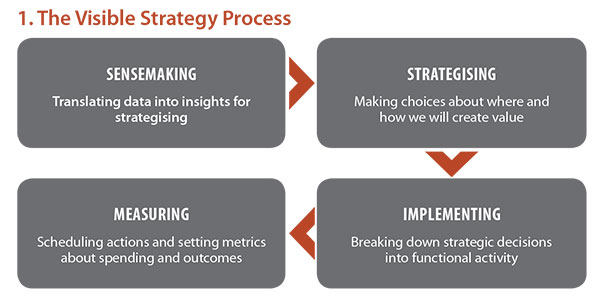
But my 20 years of working in pharma and medtech, followed by 20 years of academic research into the industry, has taught me that this four-stage process is only half the story. In the real world, there is another part of the process that is never written down and rarely discussed. I call this the shadow strategy process, because it lies, barely perceptible, beneath these four visible steps (see figure 2). Beneath the sensemaking step, we make untested assumptions about what we already know and what we need to know. In knowledge-based industries such as ours, these assumptions are very important because they shape how we create and use knowledge. Beneath the strategising step, we tacitly agree what a strong strategy looks like and how it differs from a weak strategy. That’s important because it determines which strategy is chosen. Beneath the implementation step, we implicitly set and accept expectations about what each function can do and should do. Those expectations determine the way that functions cooperate or conflict with each other. And beneath the measuring step, we reach unspoken agreements about how fast we can move and how effective we can be. Those unspoken agreements determine what we count as success or failure and therefore what we change in the next planning cycle. Experienced strategists recognise that, in the real world, this shadow strategy process goes on beneath the explicit planning process. Importantly, the shadow strategy process isn’t documented and it doesn’t happen in meetings. It mostly happens over coffee, in corridors, or when travelling together. It is an informal complement to the formal process, analogous to an adjuvant to a vaccine.
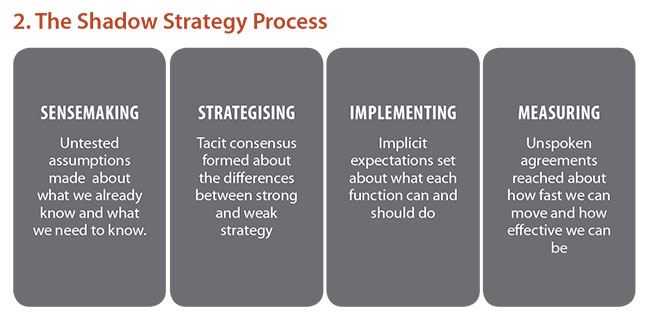
The strategy teams I study differ in how effective they are at creating strong strategies. They also vary in how physically close the strategy team is because, even before COVID-19, some teams work in the same office and some are spread around the world. By comparing what goes on in each of these four categories of strategy teams, I can draw some interesting conclusions, as shown in figure 3.
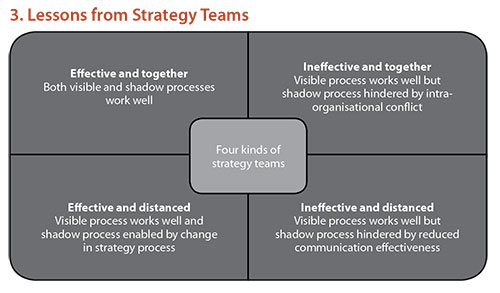
These findings lead to four important conclusions. Firstly, both the visible and shadow processes are needed to make strong strategy. This makes sense since the processes work together, like hardware and software. Secondly, physical distance has little impact on the visible strategy process. This is because the visible process centres on sharing documents and technology doesn’t care if you do this between desks or between continents. Thirdly, physical distance has a significant impact on the shadow process. This is a new finding but it isn’t surprising. The shadow process happens during informal social interactions and it is these that are curtailed by remote working. Fourth, some firms have found ways of protecting the shadow process against the negative effects of social distancing. This is a new finding and obviously one that is worth looking at more closely.
From those pharma and medtech firms that make the shadow process work, despite social distancing, we can learn two things: what they do and how they do it.
What they do is to make the shadow process outcomes visible and explicit by asking very specific questions. In particular, they ask a set of questions at each of the four stages of the strategy process, questions that are designed to provoke thought and to surface unspoken ideas.
At the sensemaking step, team members are asked structured questions to identify the different forms of knowledge they need to make strategy, what elements of that knowledge they already have and to prioritise their knowledge gaps. In a physically close team, this usually happens unconsciously as part of the social process. But in a socially distanced team, that unconscious socialisation is reduced, so the process has to be made more deliberate and conscious by asking carefully designed questions. Figure 4 shows an example template I developed from observations of good sensemaking practice.

At the strategising step, team members are asked structured questions about how likely the strategy is to meet its objectives. In a physically close team, this testing and revision of the strategy happens during the back and forth of discussion. But in in a socially distanced team, there is less opportunity for that conversational process, so it has to be enabled by asking the questions that lie underneath those conversations. Figure 5 shows an example template I developed from these observations of strategising by effective teams.
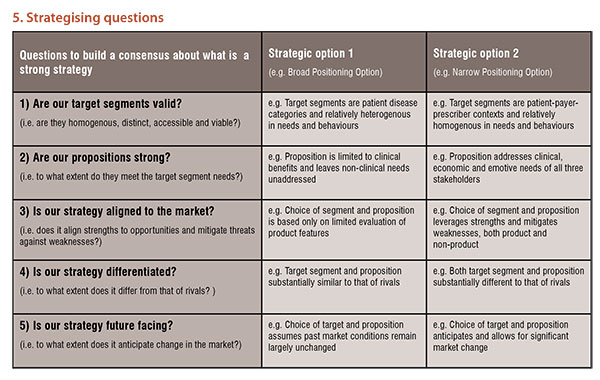
At the implementation step, team members are asked structured questions about how their tactical programmes fit with the strategy, with available resources and with each other. In a physically close team, this integration between functions takes place by repeated reiteration of tactics as gaps and conflicts become clear. But in a socially distanced team, those iterations are reduced. So they have to be made more effective by asking questions that illuminate gaps and conflicts. Figure 6 shows an example template I developed from observing teams that do this well.
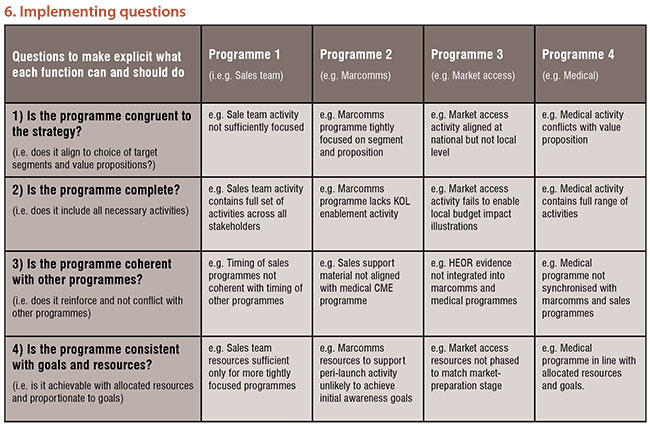
At the measuring step, team members are asked structured questions about what they want to measure and why they want to measure those things. In a physically close team, scheduling and designing of metrics evolves as the team ask each other questions during lots of informal encounters. But in a socially distanced team, those informal encounters are limited so that questioning has to be formalised by asking questions that make clear what the metrics are for. Figure 7 shows an example template I developed from these seeing teams develop effective sets of metrics.
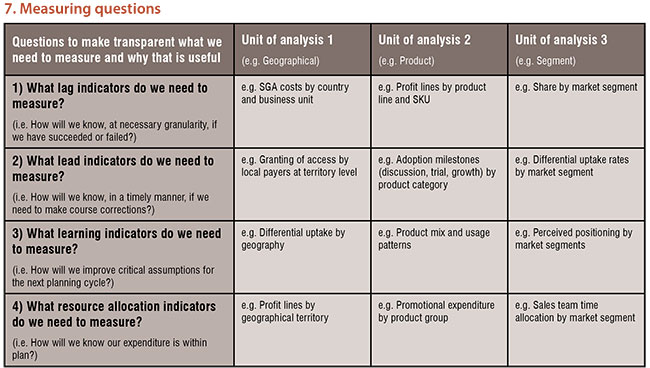
The best cross functional teams in pharma and medtech can make strong strategy even when forced to be socially distanced. They do this by asking structured questions at each stage, questions that force the shadow strategy process out into the open. These questions are not simply the “comment on this document” questions so common in the visible process. They are carefully designed to force reflection. It is this thinking that makes what is normally an informal social process happen even when that informal socialising is impossible.
Readers might ask if they really need to change their strategy process. Isn’t it complicated enough already? When I ask effective pharma and medtech companies that question, they respond with another: Our world has changed: why would you expect our strategy process to stay the same? These exemplary companies know that, in a changing world, it is those most capable of change that survive. They are evolving their strategy process to fit the new normal of social distancing because they know that the alternative to evolution is extinction.